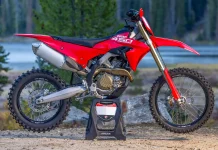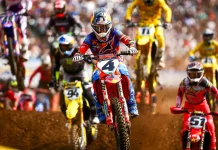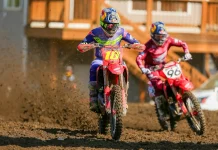
Fat Boy Lo Review
Mark down 2010 as the year that black became the new chrome. Harley-Davidson began moving in this direction with the Dark Custom line-most immediately illustrated by the Cross Bones-an antidote to traditional bling and shiny pieces to attract the ladies. A throwback concept, the Dark Custom bikes play a strong hand for the bad boy mystique of Harley-Davidson.
While not a member of the Dark Custom fraternity, the new 2010 Harley-Davidson Fat Boy Lo motorcycle is certainly a fellow traveler, with the dual goals of attracting newer, as well as shorter-inseam, riders who will appreciate its dropped seat height. Hitting the tape at 26.3 inches above the pavement unladen-over an inch closer to the ground than the standard Fat Boy-the Lo boasts the lowest stock seat height of any current Harley. This makes the 700+ pound Fatty attainable to riders who may previously have been intimidated by its substantial mass.
And, of course, intimidation is what the blacked-out and satin-chromed Fat Boy Lo is all about. Offered in two shades of black-polished Vivid and matte Denim-the Lo presents its rider as a no-nonsense enthusiast who is focused on riding above flashy profiling.
Form influences function on the Fat Boy Lo, as it takes Harley’s standard Fat Boy and removes 1.3 inches of travel from the Softail suspension travel, while leaving the beefy 41mm forks five inches of axle movement alone. This rakes out the Lo as it lowers it, adding over a half-degree of attitude projection and some straight-line stabilization. The Lo is not just lower-it also looks longer and more intimidating, though not from the owner’s perspective.
Rides through the Colorado Rockies, as well as California’s Santa Monica Mountains, confirm that the Fat Boy Lo remains a credible riding machine. What it loses in cornering clearance-about a half-degree on the right and two degrees on the left-it gains in confidence for the rider, via the lower center of gravity and stable cornering.
As usual, Dunlop’s Harley-Davidson branded tires do a fine job of securing traction all the way to the inevitable scraping, and beyond. With a wide, high-profile 140 front tire, the steering is not light. However, once set into a cornering arc, the Fat Boy Lo holds its line, even when faced with gravel or moisture. To be sure, serious line changes are a challenge, though the 200 rear does not make this impossible. Regardless, it is in the rider’s best interest to think ahead and not ride beyond what he knows-good advice on the road, regardless of your mount.
When the hillside undercarriage-dragging corners make their way to a more relaxed route, such as Interstate 40 or Pacific Coast Highway, the Fat Boy Lo settles in for the long haul. You won’t need the overdrive sixth until you top 65 mph or so, and the choice of five lower ratios, and the predictably ultra-wide powerband means that selecting the proper cog is virtually effortless. The heel-toe shifter requires more than a snick, but the transmission is a reliable gear changer-not a single false neutral is to be found.
With a dropped saddle, you sit a bit more inside the Fat Boy Lo, reducing wind blast at speed. The air flows over the triple clamp and headlight fairly nicely, producing no unpredictable turbulence. The relatively flat handlebars-one of the few chrome pieces on the bike-put your arms at a perfect cruising position. It may not project the aggressive stance of a pro-street bike or the flippin’ the bird attitude of ape hangers, but it is just right for putting in a full day of riding. The floorboards are roomy, and set at a comfortable angle that allows easy access to the foot controls.
Around town, the Lo’s big air-cooled powerplant is flawless. The 111mm stroke of the balanced Twin Cam 96B motor rewards the rider with 94 ft/lbs of torque when the engine is turning over at a leisurely 3000 rpm. This ensures muscular performance away from traffic lights, and the long and low-slung chassis design means no unwanted wheelstands or wheelspin.
One might expect a bit rougher ride from the shortened suspension-only 3.6 inches of travel in the rear-so, I was pleasantly surprised at the Fat Boy Lo’s ability to counter potholes in the neglected streets of South Los Angeles. Perhaps it is due to the subtle change in geometry, but I found the Lo’s Softail to work no better or worse than its taller brother. The forks, as per the Softail line, do a fine job, and the fat front tire helps cushion any blows.
Thinning the seat for a lower height has its consequences. While the shape of the seat is very supportive, and thin at the front to further enhance the low-seat height at stops, it is not a plush perch. Around town, it’s not as noticeable as it is on extended freeway excursions. The rear perch is abbreviated, and better suited to in-town jaunts.
With only single brake rotors at both ends-mated to disc wheels riddled with bullet-like holes-the Lo relies on the 9.2:1 compression ratio for a good amount of its braking. Performance up front is limited, so you will find yourself appreciating the added leverage a foot pedal provides. Emergency stops are controllable, even without ABS. Just as it pays to think ahead in the canyons, so, too, does it in urban settings. Take it easy. You aren’t in a rush. The Fat Boy Lo is on an image-making mission. Let it do its thing.
In a time when sales are off-peak, Harley-Davidson has made a wise move-take a solid performer and expand its accessibility to additional riders, many of whom are likely to be new. The 2010 Harley-Davidson Fat Boy Lo motorcycle is a welcoming bike that belies its menacing appearance. Starting at $16,299.
Motorcycle Specifications
|
|
|
|
Length |
94.30 in. (2395.22 mm) |
|
Overall Width |
39.20 in. (995.68 mm) |
|
Overall Height |
44.30 in. (1125.22 mm) |
|
Seat Height: • Laden2 • Unladen |
24.25 in. (615.95 mm) 26.35 in. (669.29 mm) |
|
Ground Clearance |
4.80 in. (121.92 mm) |
|
Rake (steering head) |
31.6° |
|
Fork Angle |
31.6° |
|
Trail |
5.80 in. (147.32 mm) |
|
Wheelbase |
64.50 in. (1638.30 mm) |
|
Tires (Dunlop® Harley-Davidson Series, radial blackwall front and |
|
|
• Front – D408F • Rear – D407 |
140/75R17 67V 200/55R17 78V |
|
Fuel Capacity |
5 gal. (18.93 L) |
|
(warning light at approximately 1 gal.) |
|
|
Oil Capacity (w/filter) |
3.50 qts. (3.31 L) |
|
Transmission Capacity |
1 qts. (0.95 L) |
|
Primary Chain Case Capacity3 |
1 qts. (0.95 L) |
|
Weight: • As Shipped • In Running • Gross Vehicle • Gross Axle • Front • Rear |
700 lbs. (317.52 kg) 731.25 lbs. (331.70 kg) 1160 lbs. (526.18 kg) 430 lbs. (195.05 kg) 730 lbs. (331.13 kg) |
|
Engine |
|
|
Engine4 |
Air-cooled, Twin Cam 96BTM |
|
Valves |
Pushrod-operated, |
|
Bore x Stroke |
3.75 in. x (95.25 mm x |
|
Displacement3 |
96 cu. in. (1584 cc) |
|
Compression Ratio |
9.2:1 |
|
Fuel System5 |
Electronic |
|
Air Cleaner |
Paper, washable |
|
Lubrication System |
Pressurized, |
|
Drivetrain |
|
|
Primary Drive |
Chain, 34/46 ratio |
|
Final Drive6 |
Belt, 32/66 ratio |
|
Clutch |
Multi-plate, wet |
|
Transmission |
6-Speed Cruise Drive® |
|
Gear Ratios (overall): • 1st • 2nd • 3rd • 4th • 5th • 6th |
U.S. 9.311 6.454 4.793 3.882 3.307 2.790 |
|
Chassis |
|
|
Frame |
Mild steel |
|
Swingarm |
Mild steel, round |
|
Front Forks |
41.30 mm telescopic, “beer can” covers |
|
Rear Shocks |
Hidden, |
|
Wheels7: |
Black, Bullet |
|
• Front • Rear |
17 in. x 3.50 17 in. x 6 |
|
Brakes: • Caliper Type • Rotor Type (diameter x width): • Front • Rear |
4-piston front Patented, uniform 11.50 in. x 11.50 in. x |
|
Suspension • Front Wheel • Rear Wheel |
5.10 in. (129.54 mm) 3.60 in. (91.44 mm) |
|
Performance |
|
|
Engine Torque (per SAE J1349): |
|
|
• North America |
93.67 ft. (127.0 Nm @ 3000 |
|
Lean Angle (per SAE J1168): |
|
|
• Right • Left |
25.6° 25.2° |
|
Fuel Economy (EPA urban/highway test) |
35/54 mpg (6.72/4.36 L/100 km) |
|
Electric |
|
|
Battery (per Battery Council International Rating) |
Sealed, |
|
Charging |
Three-phase, (439W @ 13V, 2000 |
|
Starting |
1.2 kW electric |
|
Lights (as per country regulation): |
|
|
• Headlamp (quartz halogen) • Tail/Stop Lights • Turn Signal Lights • Indicator Lamps |
55-watt low beam, 60-watt high beam 8W/28W (5W/21W) 28W (21W) self-canceling High beam, neutral, low oil pressure, turn signals, |
|
Warranty |
|
|
Warranty9 |
24 months (unlimited mileage) |
|
Service Interval |
First 1,000 miles (1,600 km), every 5,000 miles (8,000 km) thereafter |





